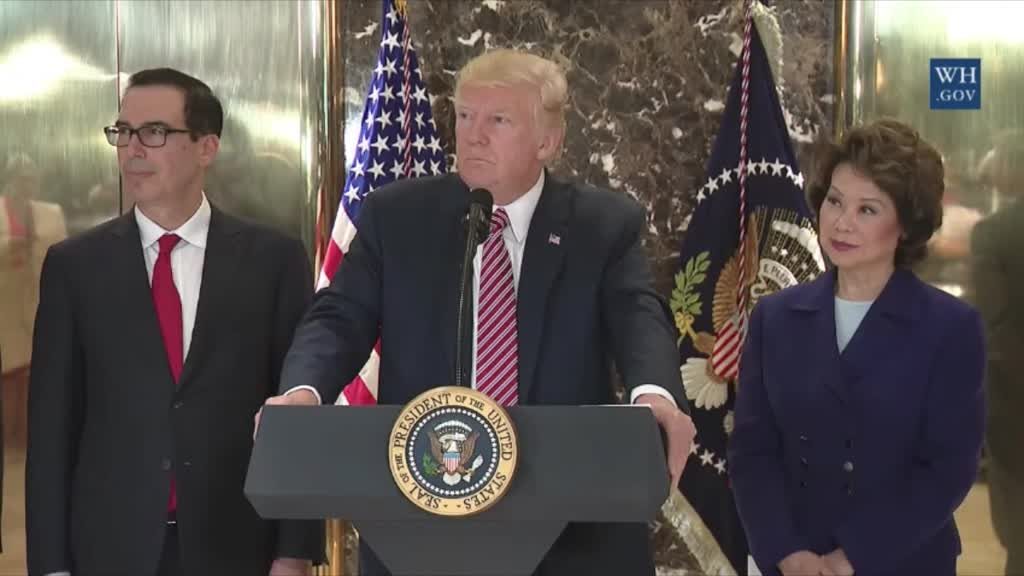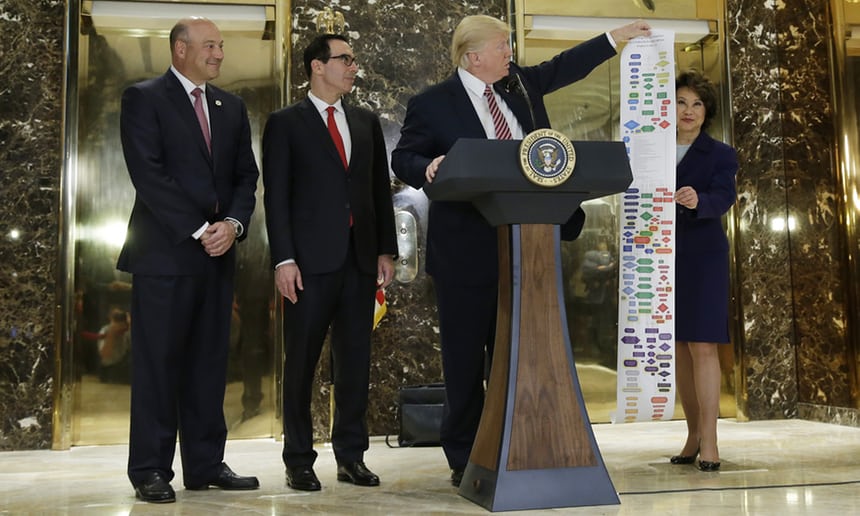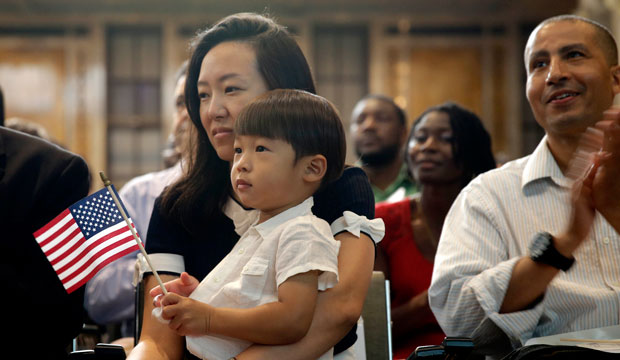
Earlier this week, President Trump held a press conference in the lobby of Trump Tower, where the president — flanked by Transportation Secretary Elaine Chao and Chief Economic Advisor Gary Cohn — delivered an impromptu series of remarks on the weekend’s white supremacist violence in Charlottesville.
It was the President’s third commentary on the neo-Nazi rally in Virginia that left one woman — Heather Heyer, 32, — dead and eighteen others injured after a white supremacist drove his car into a crowd of non-violent counter-protesters. In his initial remarks delivered soon after Heyer’s killing, Trump refused to condemn neo-Nazi demonstrators and instead blamed the violence “on many sides”; he received widespread and bipartisan criticism for the equivocation. The White House was quick to attempt damage control, issuing a tepid statement that attributed condemnation of white supremacists to an unnamed White House representative. On Monday — more than 48 hours after Charlottesville was besieged by white supremacists — Trump also delivered a prepared statement that labeled white supremacists and neo-Nazis as “repugnant”. Again, Trump was widely criticized for offering too little, too late. Within hours of issuing those second comments, Trump returned to Twitter to rail against his critics for being dissatisfied with the remarks.
By Tuesday, Trump was once again ready to give up the charade that he was not on the side of neo-Nazis. In Tuesday’s press conference — ostensibly held to unveil the administration’s latest infrastructure reforms — Trump doubled down on his moral equivalence between violent white supremacists and the counter-protesters who demonstrated against their racism. Manufacturing a supposed “alt-left” (experts agree that the term was invented by conservative media as a slur against leftists), Trump alleged that left-wing activists attacked white supremacists with clubs and provoked the weekend’s violence. Trump concluded his bizarre commentary by undermining his previous day’s remarks and blaming “both sides” for Charlottesville, albeit with more of his moral outrage directed towards leftist counter-protesters.
For a man who has built his entire career around manipulating the media to fuel his own preening self-image, it’s hard to believe that Trump had not planned to issue fresh remarks on Charlottesville on Tuesday. It’s also hard to miss the optics of Tuesday’s press event: Trump stood in steadfast defense of white supremacist terrorists while he surrounded himself with the highest-ranking woman of colour in his administration as well as one of his most senior Jewish American advisors. Trump presented himself alongside Chao and Cohn as if to say: “no matter what spews out of my mouth today, I can’t be accused of being racist; look who my friends are!”
This week hardly marks the first time that Asian Americans have been used as rhetorical shields from accusations of racism. After all, such treatment emerges as a logical extension of the Model Minority Myth, which positions Asian Americans as the palatable, well-behaved, “good” minority who can be leveraged against other people of colour. The Right is particularly deft at deploying its Asian American members as shields against racism. Indeed, anti-affirmative action groups currently appealing to the Supreme Court “on behalf” of Asian American plaintiffs stand as a primary example of this tactic: anti-affirmative action partisans (including Supreme Court Justice Samuel Alito in his Fisher v University of Texas) explicitly argue that because their plaintiffs are non-white, their position must therefore be classified as a fight to end (not reinforce) racial injustice. Recently, the Trump Administration decided to reopen this issue: the Department of Justice launched a new effort to investigate Ivy League universities’ college admissions treatment of Asian American applicants.
And sometimes, members of our community do it to ourselves. For example, the leader of the organization behind several white nationalist rallies, Joey Gibson, identifies himself as Japanese American and cites his race as evidence that the rallies are not racist.
Asian Americans are once again positioned as racial wedges against other minorities. Once again our non-white skin is put on display as if our mere proximity is proof of the racial morality of “Important White Men”, even as those same men enact violence against communities of colour. For an administration plagued with daily accusations of racism, it should come as no surprise that once again Asian Americans are being trotted out as if we are nothing more than human shields against being found racist.

On Tuesday, Trump used Transportation Secretary Elaine Chao for the same purpose. One can only imagine what was going through Chao’s head as she was conscripted to hold some absurdly complicated, multi-coloured flowchart the length off her whole body while Trump rambled about infrastructure and then likened non-violent anti-racism activists to Nazis. Chao, like Mnuchin and Cohn, literally stood silently by as Trump defended white nationalists, neo-Nazis, and Klansmen.
Since Tuesday, Chao has refused to issue a statement rebuking her boss or his remarks. Instead, when asked about President Trump at Tuesday’s press conference, Chao refused to offer any sort of indication that she thinks for herself. All Chao had to say for herself? She “stands by [her] man… both of them.” That answer did nothing but reinforce the sexist trope that women — and particularly Asian American women — are meek, submissive, unassertive, ego-boosting accessories for the men they might find themselves next to.
Ugh. Just ugh.
Whether we like it or not, Transportation Secretary Elaine Chao is objectively one of the most qualified members of Trump’s Cabinet. Chao has served for nearly thirty years in the federal government, including for three years as Deputy Secretary of Transportation under George H.W. Bush. As much as I detest Chao’s politics — and I do — no one can deny her qualifications for service as Transportation Secretary. For a Cabinet that includes Ben Carson as Housing Secretary and Governor Rick Perry as Energy Secretary, Chao’s appointment as Transportation Secretary offered some measure of hope that someone would know what they were doing in the Trump Administration.
So it’s absolutely frustrating to watch as one of the most powerful Asian Americans in the federal government allowed herself to be treated as a literal human poster stand as the American president defended white nationalists and an act of domestic terrorism. Since Tuesday, Trump has lost two business advisory councils and his entire Committee on the Arts and the Humanities — which includes two Asian American members — has resigned. So, where is Chao? Standing silently “by her men”, apparently.
Asian American community groups have come together since Tuesday demanding that Chao speak up and speak out against Trump’s commentary. In the hashtag #DisavowChao, groups like Asian Americans Advancing Justice are calling on Chao (@SecElaineChao) through Twitter to push back against Trump’s response to Charlottesville.
We want @SecElaineChao to stand with Asian Americans against white supremacy! #DisavowChao https://t.co/i5B0amdati pic.twitter.com/WeKBo2NdKA
— AdvancingJustice|Chi (@AAAJ_Chicago) August 16, 2017
I believe Chao is fully capable of taking a stance for herself: so why hasn’t she done so yet? So long as Chao and the rest of Trump’s advisors and staff remain silent, they remain complicit in the hateful rhetoric of white supremacy and intolerance. And, as long as Chao “stands by” the racism of President Trump, I will disavow Chao and her refusal to take a moral stand against hate.

